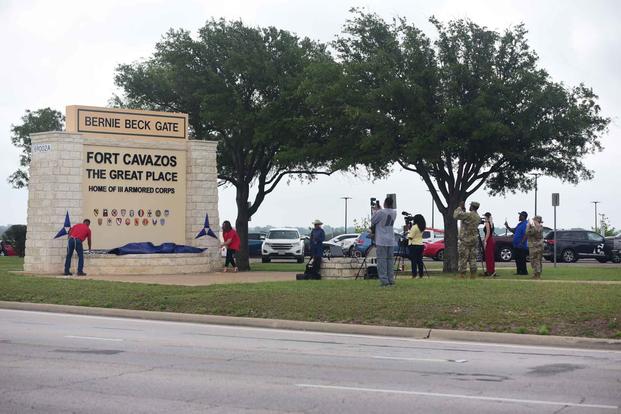The two 1st Cavalry Division soldiers accused of lighting fires and painting racial slurs and a penis on the walls of a Fort Cavazos, Texas, barracks two months ago have not faced charges and their unit has not taken disciplinary action, according to the Army.
The soldiers are accused of painting the N-word on at least three different places in a barracks building on April 22, shown in photos of the incident reviewed by Military.com. The pair also are accused of lighting part of the laundry room on fire and spray-painted male genitalia on a wall.
A service spokesperson, citing an ongoing investigation, confirmed to Military.com that despite the elapsed time since the incident, no soldiers have been charged and local commanders have taken no disciplinary action so far.
Read Next: Alleged Shooter Who Killed 2 at Music Festival Is Army Ranger Based at JBLM
"The Army does not condone these deliberate acts of vandalism as they run counter to Army values and standards of conduct," Maj. Tim Watts, a spokesperson for the 1st Cavalry Division, said in a statement. "It is Army policy not to comment on open investigations. The Army will take the necessary steps to ensure appropriate disciplinary action is taken against those involved once the investigation is completed and provided to the command."
While criminal investigations are known to move slowly, those proceedings are separate from actions a commander can take, including reduction of rank or extra duty. The service declined to comment on who the soldiers accused of the vandalism are or their unit.
"These people have done harm to their community and made their fellow soldiers feel unsafe; they're revealing the military has done nothing to weed these people out," Kris Goldsmith, an Army veteran and CEO of Task Force Butler, a nonprofit focused on combating extremism in the military, told Military.com. "The victims are fellow service members and deserve to see these guys spend a few years in [prison], and the Army needs to rehabilitate these guys."
Concerns of "overt" and "in your face" racism were noted by numerous soldiers in private surveys on base, according to the findings of the Fort Hood report, a damning investigation in the aftermath of the slaying of Spc. Vanessa Guillén. In June, the installation was renamed for Gen. Richard Cavazos, a decorated combat veteran of two wars and the first Latino four-star general.
Though details have not been released, including the race of the two suspects, the N-word slur used in the vandalism echoes the sporadic racism sometimes found in the military, as well as white supremacist activity that has been on the rise across the U.S. in recent years.
The long wait for any potential punishment in the vandalism comes as the military grapples with systemic racism in its ranks and in its criminal justice system. A Pentagon study released this month found that "significant racial disparities" exist across investigations and criminal justice.
The study pointed to bias among junior officers and supervisors -- how they treat and handle subordinates, including early discretionary decisions -- having the biggest effect on the unequal treatment of minority service members when it comes to reprimands and punishments.
-- Steve Beynon can be reached at Steve.Beynon@military.com. Follow him on Twitter @StevenBeynon.
Related: Soldier Who Sought Ethnic Cleansing in the US Pleads Guilty on Firearms Charges












